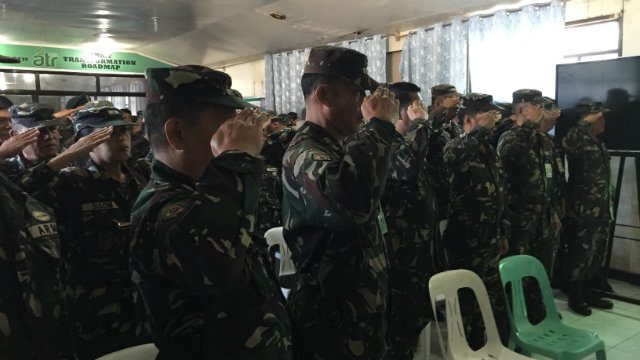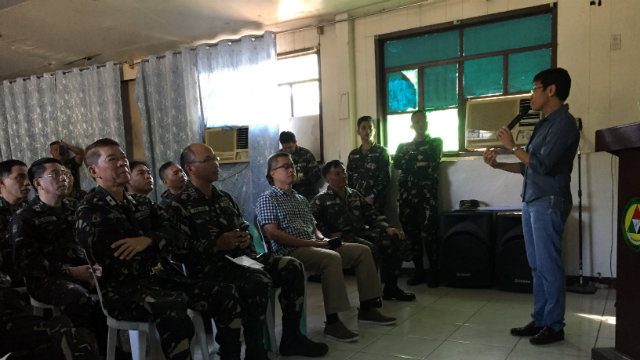SUMMARY
This is AI generated summarization, which may have errors. For context, always refer to the full article.

MANILA, Philippines – In the event of a national crisis or calamity, there is a group of men and women already in the field and ready to respond. They aren’t super heroes and they don’t have special powers. They are, in fact, normal people who have volunteered to defend the country and help the people, if called upon to do so.
The men and women of the Armed Forces of the Philippine Reserve Force are mandated to augment the regular military force during times of national emergencies like a foreign invasion or government collapse. Yet, little is known about them, even within the military organization. Many of the 100,000 volunteers nationwide come from humble backgrounds while others have corporate day jobs. One thing they share in common is a desire to be of service to their country.
“Reserves” are often the last group to be called into active duty in the event of a war or coup. But in times of disasters, the roles reverse.
According to Brigadier General Marcelo Javier Jr, Commanding Officer of the 15th Infantry Division (Ready Reserve), Reserves act as the first line of defense in their communities during a disaster.
“Where are the camps? Along EDSA and other roads. When the big one hits the electric posts will go down. You will have to clear that first. And before you clear that, it will take days, at least hours to clear that,” said Javier.
Javier, who is also a Director in the Philippine Red Cross Muntinlupa Branch, believes citizens cannot solely rely on the government to help each of them when disaster strikes because the government and the military will need to deal with big problems like ensuring peace and order and saving lives.
Inform and educate
But how can ordinary volunteers with little to no training in disaster preparedness and response help save lives? One way is by being community organizers and educators.

On Sunday, March 29, Rappler’s civic engagement arm, MovePH, in partnership with the NCR Regional Community Defense Group of the Army Reserve Command conducted an orientation for 250 Reserve troopers on how to use social media to better inform and educate the public about how to prepare for a disaster.
Rappler CEO Maria Ressa introduced Project Agos, Rappler’s platform for disaster information management and multi-sectoral collaboration for disaster preparedness. Ressa talked about how the government, the military, and the public can collaborate for top-down decision making and bottoms-up civic action through Project Agos. She also demonstrated how social media can be used to spread good ideas and build stronger networks that would be useful in times of crisis.
Zak Yuson, Head of Civic Engagement at Rappler, Jed Alegado, Agos Campaign Manager, and Philip Fortuno, Community Development Specialist, dived deeper into how social media platforms like Twitter, Facebook and the Project Agos Alert Map are being used to improve communication and coordination for crisis response.
Speaking on behalf of the participants, Javier said that learning how social media works is essential for performing their duty as Reserves to be “forward deployed” and always capable and available to help the public in times of crisis.
MovePH and the NCR Regional Community Defense Group, led by Col Corleto S. Vinluan Jr, will continue to train officers and members of the Reserve Force as well as cadet officers of the Reserve Officers’ Training Corps (ROTC) in different universities in Metro Manila. The collaboration is part of a long-term partnership between MovePH and the Armed Forces of the Philippines for its ongoing disaster risk reduction and management and climate change adaptation (DRRM-CCA) program, which is supported by the Australian Government.
Preparedness stars at home
For Javier, his years of training in crisis management has led him to one conclusion: preparedness starts with the family. Javier is a staunch advocate of “pre-incident planning” where each member of the family knows what to do during a disaster.
Each member of the family should be given a specific task relative to their capability. He advises every family to divide themselves into teams responsible for either food, shelter, search and rescue, and security.
On a larger scale, neighbors on a street should also plan and act together before, during and after a disaster to pool food and ensure the safety of their community. Acting alone will not ensure survival, Javier said, only cooperation and having proper systems in place will.
“When the big one hits, government will have a very difficult time to respond because of mobility problems. A lot of streets will be blocked. People will be in chaotic mode. What you need is leadership in chaos. For us in the Reserves, we consider this as a primary mission. Like it or not, in the event of an emergency, people will look up to you and ask, ‘what are we supposed to do?’ We can tell them, ‘this is what you’re supposed to do before the disaster, then people will just move towards their individual assignments.” said Javier.
“Government has the mandate to protect the people, but the citizen has the responsibility to preserve his life,” he added. – Rappler.com
Add a comment
How does this make you feel?
There are no comments yet. Add your comment to start the conversation.